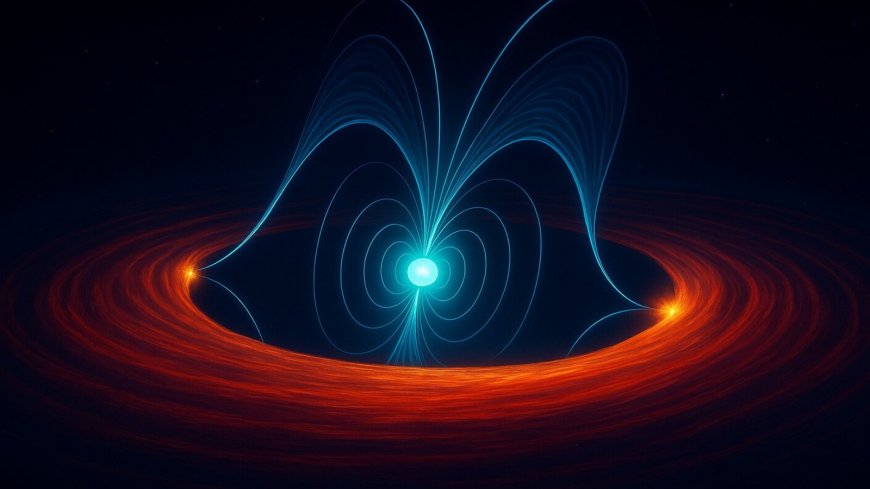NASA X-ray Spacecraft Uncovers Secrets of a Rapidly Spinning Neutron Star
Astronomers have found that the radiation from the neutron star PSR J1023+0038 is mainly influenced by its powerful particle winds rather than the material it takes from its companion star. This discovery sheds light on the behavior of transitional millisecond pulsars like J1023, providing valuable insights into the evolution of neutron stars in binary systems.

An illustration of the pulsar system PSR J1023+0038 showing the central pulsar and an accretion disk around it.
Astronomers have discovered that radiation emitted by a rapidly spinning neutron star, or \"pulsar,\" is dominated by the impact of its powerful particle winds — and not by the material it strips from a companion star.
The pulsar in question is PSR J1023+0038 (J1023), which sits in a binary system located 4,500 light-years away from Earth. This binary consists of a \"dead star,\" or neutron star that spins around 600 times a second, as well as a low-mass star upon which the neutron star \"feeds.\"
The rapid spin of J1023 classifies it as a millisecond pulsar, but because it transitions clearly between an active state — during which it feeds and blasts out beams of radiation from its poles — and an inactive state, it is part of a rare subclass called \"transitional millisecond pulsar.\" One of just three known transitional millisecond pulsars, J1023 is an invaluable target for astronomers.
\"Transitional millisecond pulsars are cosmic laboratories that help us understand how neutron stars evolve in binary systems,\" team leader and National Institute for Astrophysics (INAF) researcher Maria Cristina Baglio said in a statement. \"J1023 is a particularly valuable source of data because it clearly transitions between its active state, in which it feeds on its companion star, and a more dormant state, in which it behaves like a standard pulsar, emitting detectable radio waves.\"
The matter this neutron star strips from its companion doesn't fall straight to the surface of the dead star, but instead forms a flattened cloud, or \"accretion disk\" around the star. As this disk swirls around the neutron star, gradually feeding it, it emits powerful radiation consisting of wavelengths across the electromagnetic spectrum.
Thus, the team was able to examine J1023 using NASA's Imaging X-ray Polarimetry Explorer (IXPE), the European Southern Observatory's (ESO) Very Large Telescope (VLT) in northern Chile, and the Karl G. Jansky Very Large Array (VLA) in New Mexico, making this the first survey of binary X-ray source over the X-ray, optical and radio bands of the electromagnetic spectrum.
\"During the observations, the pulsar was in a low-luminosity active phase, characterized by rapid changes between different X-ray brightness levels,\" Baglio said.
An illustration of a rapidly spinning neutron star or \"pulsar.\" (Image credit: Robert Lea (created with Canva)/NASA)
Assessing J1023 across three bands of the electromagnetic spectrum allowed the team to determine the polarization of radiation coming from this pulsar. Polarization refers to the orientation of light waves as they propagate.
Of particular note was IXPE's observation that 12% of the X-rays from J1023 are polarized. That is the highest level of polarization ever seen from such a binary star system.
The radio wave and optical light emissions showed lower polarizations of 2% and 1%, respectively. What was particularly interesting about the optical polarization was the fact that it was oriented in the same direction as the angle of X-ray polarization. This suggests a common mechanism behind the polarization of X-rays and the polarization of optical light.
The findings confirm an earlier theory that suggested the observed polarized emissions from binary systems such as J1023 are generated when pulsars' winds, streams of high-energy charged particles flowing from these dead stars, strike the matter in the surrounding accretion disks.
This research could finally help scientists understand what powers pulsars, and it wouldn't have been possible without the sensitivity of IXPE.
\"This observation, given the low intensity of the X-ray flux, was extremely challenging, but the sensitivity of IXPE allowed us to confidently detect and measure this remarkable alignment between optical and X-ray polarization,\" team member and INAF researcher Alessandro Di Marco said. \"This study represents an ingenious way to test theoretical scenarios thanks to polarimetric observations at multiple wavelengths.\"
The team's research was published on July 1 in The Astrophysical Journal Letters.
What's Your Reaction?
 Like
0
Like
0
 Dislike
0
Dislike
0
 Love
0
Love
0
 Funny
0
Funny
0
 Angry
0
Angry
0
 Sad
0
Sad
0
 Wow
0
Wow
0



















































































































































































